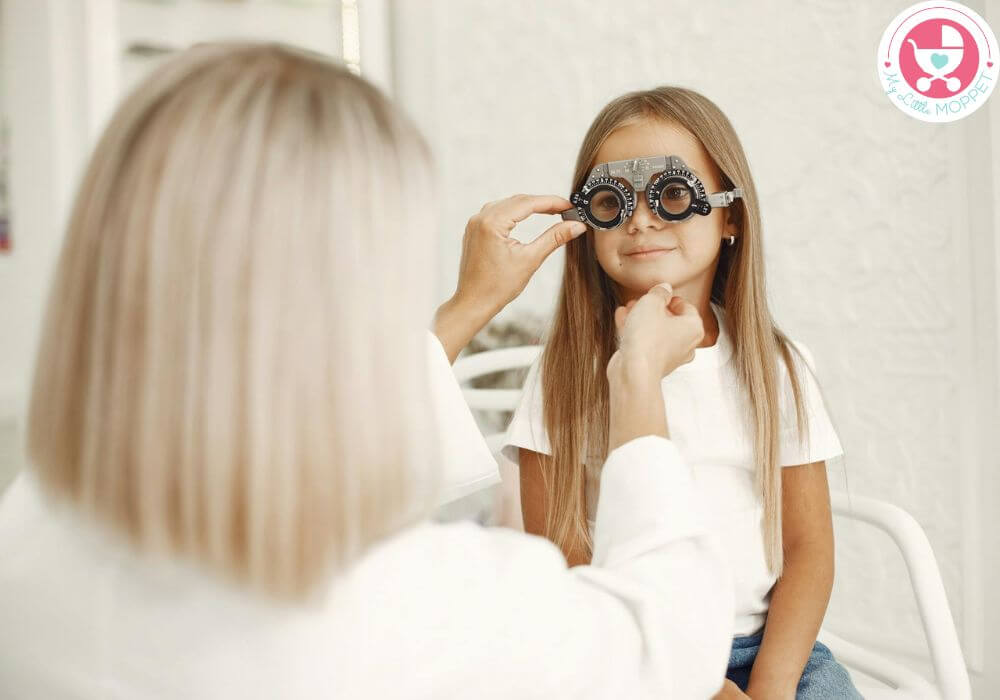Here’s a look at the most common eye problems in children—their signs, causes, and treatments. Early detection and treatment give the best results!
When you’re a new parent, one of the most heartfelt moments you’ll experience is when your little baby looks up, locks eyes with you and smiles. That happy face, that expression is of the purest love you’ll ever know! Your baby now recognizes you; not just Mommy or Daddy, but his entire world!
Of course, that doesn’t happen as soon as your child is born; newborns have very poor eyesight! It takes time for them to make sense of the world around them, as their vision develops gradually over months.
Normal Vision Development in Children

Birth: Newborns are sensitive to bright light, which is why their pupils appear small. They have limited peripheral and central vision.
2 Weeks: Your baby’s pupils get bigger, and they can now differentiate between light and dark. They may also focus on an object directly in front of them.
1 Month: Baby’s eyes may appear crossed or wandering, which is normal at this age. They seem interested in high contrast images and may look at you for a short time. Tears start to appear at this time.
2 Months: By this age, babies can follow an object with their eyes. They begin to observe their own hands.
3 Months: A 3-month-old often has enough hand-eye coordination to swipe at a moving object
4 Months: By this age, any crossing or wandering of the eyes should have gone away. They begin to look at themselves in the mirror.
5 Months: Your baby can now perceive how far an object is, and can reach out for objects. They can also see colors better and recognize their parent from across the room.
6 Months: By the half-year mark, babies will turn their heads to look at something. They may also touch their reflection in the mirror.

7 Months: Your baby can see longer distances now and has enough coordination to pick up a dropped toy.
8 Months: Now your baby is mobile, crawling and moving thanks to improved hand-eye coordination. They can observe smaller objects and enjoy playing peek-a-boo.
9 Months: As your baby tries to stand with support, they can judge distances and heights. Their color vision is fully developed by now.
10-11 Months: Babies develop the pincer grasp, now that they can spot small objects and grasp them between the thumb and forefinger.
1-2 Years: Many babies attempt walking after the first birthday, and as they learn to climb and jump, their depth perception skills come into full use.
3-4 Years: They have visual memory, which means they can recall and copy things they’ve seen. They’ve got better fine motor skills and hand-eye coordination and can start reading an eye chart.
5-6 Years: Early school-goers can recognize letters and numbers. Their eyes can now move together at good speed, enabling them to read from left to right. They are also better able to judge distances and prevent falls and bumps.
Please remember that developmental milestones always follow a rough schedule, and aren’t written in stone. Premature baby milestones will differ, as they will be based on the baby’s initial due date, not the date they were born. Delayed milestones aren’t always a sign of eye problems in children.
Any delay in a baby’s vision development can affect their overall growth, so it’s important to keep track of how your baby is doing. The earlier you are able to catch a problem, the faster you can fix it and the better the outcome will be. Here is a look at the most common eye problems in children and their signs.

1. Refractive Errors

Refractive errors are the most common eye problems in children. These include:
- Myopia (nearsightedness) – When near objects are clearer than those at a distance
- Hyperopia (farsightedness) – When close objects appear blurry but distant ones are clear
- Astigmatism – When both near and distant vision appear blurry or distorted
Symptoms of refractive errors are frequent squinting, holding books or screens too close to the face, sitting too close to the TV or computer, or headaches after reading or looking at screens. If you notice your child suddenly making mistakes in schoolwork, it may be because they’re having trouble seeing properly.
Some children may have more than one refractive error at once. Refractive errors are mostly fixed with corrective lenses, in the form of spectacles or contact lenses. Please note that procedures like LASIK are not recommended for children under the age of 18.
2. Lazy Eye (Amblyopia)

Amblyopia occurs when one eye doesn’t develop as well as the other and ends up becoming a ‘lazy eye’. Due to the lazy eye being unable to work well, the load of seeing properly is borne by the ‘good’ eye. If left untreated, this can lead to long-term issues.
Untreated eye problems in children, like refractive errors, strabismus or droopy eyelids, can also cause lazy eye. Lazy eye can be difficult to diagnose, since the child manages to see with the ‘good’ eye. However, you can watch out for these signs: difficulty doing schoolwork, inability to focus for long, squinting, frequently rubbing or closing one eye.
The good news is that early diagnosis can completely reverse amblyopia. Treatment generally involves glasses, eye drops or patching the ‘good’ eye to stimulate the weaker eye. In some cases, surgery may be required to correct the problem.
3. Crossed Eyes (Strabismus)

Strabismus is when the eyes are crossed, i.e. misaligned or pointing in different directions. Healthy vision relies on both eyes working in sync, and strabismus hinders this. Babies having crossed eyes is considered normal till the age of four months, but if left untreated after that, it can lead to serious issues, even vision loss.
Strabismus is among the eye problems in children that’s easy to identify, since it’s visibly prominent. One eye points straight, while the other points in, out or down. Children with crossed eyes often squint in an effort to see clearly. If detected early, it can be corrected with patches or glasses, while surgery may be needed in some cases.
Strabismus is not to be confused with Pseudostrabismus, which is normal till 6 months of age, or even till 12 months if the child has a wide nasal bridge or extra skin folds between the nose and eyes. They usually outgrow this, although it’s best to get it checked out first.
4. Ptosis (Drooping Eyelid)

Ptosis is the drooping of the upper eyelid, which blocks light from passing to the retina. This creates blurry images in the eye, leading to vision problems like astigmatism or amblyopia. The drooping is often due to weak muscles in the eyelid, and it can be present at birth or be a result of a neurological condition.
Ptosis can be easily diagnosed by spotting the droopy eyelid, and it also causes children to lift their head in order to see out of the affected eye. Surgery is the solution for a severe case of ptosis, where the drooping eyelid is lifted so that enough light enters the eye, restoring vision.
5. Blocked Tear Duct

When a child has a blocked tear duct, the eyes are unable to drain tears normally. Eventually, the tears collect in the mucus, leading to irritated or infected eyes. About 20% of babies are born with this condition, and many cases resolve on their own by the first birthday.
Babies with blocked tear ducts tear up even when they’re not crying, and rub their eyes often. If infected, the eyes appear swollen and red, with mucus coming out. A special, gentle massage can unclog the tear duct, but if that doesn’t work, surgery may be required.
6. Pediatric Cataracts

Cataracts are often considered an old-person problem, but the truth is that it can affect children too. Nearly 20,000 to 40,000 babies are born with cataracts every year, and some children can also get them from an injury. Cataracts can range from mild to severe, causing serious eye problems in children.
The main sign of cataract is a cloudiness of the eye, when the clear lens becomes opaque or when a white area appears in the pupil. Children with cataracts can have difficulty identifying people or objects, and may also display signs of amblyopia or Nystagmus.
It is crucial to treat cataracts as early as possible to restore proper vision. Treatment is often a surgical procedure, followed by glasses or patching.
7. Retinopathy of Prematurity (ROP)

Premature babies have special health challenges since they were unable to complete their full development in-utero. One of the eye problems in children born prematurely is Retinopathy of prematurity (ROP), where the blood vessels in the retina haven’t fully developed. ROP affects both eyes and often gets worse with time, leading to strabismus, cataract or even blindness.
ROP is usually diagnosed in the hospital during regular screenings of premature babies. Treatment of ROP depends upon its stage and includes laser therapy, cryotherapy, injections or scleral buckle vitrectomy.
8. Nystagmus

Nystagmus is a condition where the eyes make repetitive, rhythmic movements involuntarily. The eyes may move up and down, side to side, or rotationally. This affects proper depth perception, coordination and balance.
This condition may be present at birth, appearing before six months of age, or it may occur as a side effect of a neurological condition or other eye problems in children. Children with nystagmus may nod and tilt their heads in an effort to see clearly. They may also struggle with increased light sensitivity, dizziness or trouble seeing in the dark.
Nystagmus is one of those eye problems in children that cannot be treated completely, but it can be managed with corrective lenses, better lighting and using books with large print.
9. Conjunctivitis (Pink Eye)

Conjunctivitis is the term used to refer to any irritation of the white part of the eye, whether due to infections or allergies. It is called ‘pink eye’ since the eye usually gets a reddish tinge as a result of the irritation.
If your child has conjunctivitis, you may observe a sticky discharge or tearing, along with an irritated, reddish eye. The child may complain of itchiness or a feeling of having something in the eye. This condition is generally harmless and goes away on its own within a week’s time, although eye drops can offer some comfort for the irritation.
Conjunctivitis may be due to allergies or viruses and bacteria, in which case it can be contagious. Keep your child home from school and encourage them to wash their hands frequently to avoid the infection from spreading.
10. Blepharitis, Stye and Chalazion

Blepharitis, stye and chalazion are all common eye problems in children that have similar symptoms.
Blepharitis is an inflammation of the oil glands in the eyelid, causing swelling in the eyelids and crusting on the eyelashes.
A stye is a red, painful bump on the eyelid due to a bacterial infection of the sweat gland or oil gland.
A chalazion also appears as a bump on the eyelid, but it is caused by clogged oil glands rather than an infection.
All these conditions can be managed at home with warm compresses or eye drops. If there is an infection, antibiotics may be required. If the chalazion is severe, your child may need a small surgical procedure to fix it.
11. Cellulitis

Cellulitis is an infection that can occur anywhere on the body, but when it occurs in the tissues in the front and back of the eye, it is known as pre-septal cellulitis and orbital cellulitis, respectively.
The most common cause of cellulitis of the eye is an infection with bacteria, which usually begins in the sinuses. Another reason is an injury to the eye. Symptoms of cellulitis include painful swelling in the eyelids, bulging of the eyeball, difficulty moving the eyes, blurry vision, redness and fever.
Cellulitis needs immediate treatment, which will be based on the kind of infection. Pre-septal cellulitis is treated with oral or IV antibiotics. Orbital cellulitis is treated with IV antibiotics, but severe cases may require surgery to drain the sinuses.
Tips to Prevent Eye Problems in Children

0-3 months
- Keep toys within 8-12 inches of the baby’s line of vision
- Hang a mobile on top of baby’s crib so they can look at the objects move
- Carry the baby as you walk around and point to objects
- Use a dim light in the baby’s room at night
- Alternate right and left sides during each feeding
3-6 months
- Increase tummy time and keep toys in baby’s line of sight
- Have a play gym so baby can bat at hanging objects
- Play peek-a-boo with baby using dolls or stuffed toys
- Play pat-a-cake with baby’s hands
7 to 12 months
- Give the baby blocks to hold and stack
- Introduce books with pictures of everyday objects
- Encourage the concept of object permanence by playing hide and seek with toys
- Encourage crawling and other floor-time play activities
Toddlers:
- Encourage your child to throw or kick a ball in a particular direction
- Introduce pretend play using the right names for play pieces
- Read stories with text, and point to the words moving from left to right
Older Kids:
- Give them toys to promote hand-eye coordination, like puzzles and peg boards
- Encourage them to make arts and crafts projects like stringing beads or weaving paper
- Hand them paper and art supplies to draw and paint
- Let them play outdoors – more time outdoors has been associated with fewer eye problems in children
- Limit the use of screens of any size
- Feed them nutrient-rich foods like green leafy vegetables, carrots, seafood and citrus fruits
- Encourage them to wear hats and sunglasses on sunny days
- Schedule regular eye checkups, especially before starting the school year

Even if your little one does not show signs of any eye problems in children, it is recommended to take your child for regular eye checks, starting at about 1 year of age. The doctor will test for refractive errors, eye movement, alignment and other factors. Young kids are not likely to tell you when something’s wrong, so these checks are crucial, especially in the early years.
At the same time, keep a lookout for any of these signs:
- Excessive squinting, blinking or rubbing of the eyes
- Crossed eyes or unfocused eyes
- Eyes that keep fluttering
- Red or swollen eyes
- Extreme sensitivity to light
- Any kind of fluid draining from the eyes
- Drooping eyelids
- A white or gray area in the pupils
- Complaints of blurry or double vision
- Reluctance to read or write
- Standing too close to screens or holding books too close
- Tilting the head to see
- Frequent headaches or dizziness
If you notice any of these signs, please go to your doctor and get your child’s eyes checked out. Remember, the early you detect a problem, the better the outcome will be!
References:
Buy Healthy Nutritious Baby, Toddler food made by our own Doctor Mom !
<!–
–>
!function(f,b,e,v,n,t,s)
{if(f.fbq)return;n=f.fbq=function(){n.callMethod?
n.callMethod.apply(n,arguments):n.queue.push(arguments)};
if(!f._fbq)f._fbq=n;n.push=n;n.loaded=!0;n.version=’2.0′;
n.queue=[];t=b.createElement(e);t.async=!0;
t.src=v;s=b.getElementsByTagName(e)[0];
s.parentNode.insertBefore(t,s)}(window, document,’script’,
‘https://connect.facebook.net/en_US/fbevents.js’);
fbq(‘init’, ‘155662071843833’);
fbq(‘track’, ‘PageView’);
!function(f,b,e,v,n,t,s)
{if(f.fbq)return;n=f.fbq=function(){n.callMethod?
n.callMethod.apply(n,arguments):n.queue.push(arguments)};
if(!f._fbq)f._fbq=n;n.push=n;n.loaded=!0;n.version=’2.0′;
n.queue=[];t=b.createElement(e);t.async=!0;
t.src=v;s=b.getElementsByTagName(e)[0];
s.parentNode.insertBefore(t,s)}(window, document,’script’,
‘https://connect.facebook.net/en_US/fbevents.js’);
fbq(‘init’, ‘1129675213727539’);
fbq(‘track’, ‘PageView’);
(function(d, s, id) {
var js, fjs = d.getElementsByTagName(s)[0];
if (d.getElementById(id)) return;
js = d.createElement(s); js.id = id;
js.src = “//connect.facebook.net/en_US/sdk.js#xfbml=1&version=v2.3”;
fjs.parentNode.insertBefore(js, fjs);
}(document, ‘script’, ‘facebook-jssdk’));
Source link




